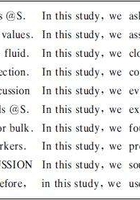
2.4.4 Extended Unit of Meaning
Sinclair proposes a hypothesis that“the notion of a linguistic item can be extended...so that units of meaning are expected to be largely phrasal”(2004:29-30).In order to find evidence of extended units of meaning and to justify his position that phraseology“is due to become central in the description of English”(ibid:30),Sinclair(ibid:30-44)chooses two compound items(naked eye and true feelings)and two single words(brook and place)to investigate how they can be closely integrated into their cotext and to confirm the interdependence of meaning and cotext.
Five categories of co-selection are put forward as components of a lexical item:core,collocation,colligation,semantic preference,and semantic prosody.The core,or the node word in a concordance,is obligatory and invariable.Another obligatory component is the semantic prosody which determines the meaning as a whole.The remaining three components are optional which“realize co-ordinated secondary choices within the item,fine-tune the meaning and give semantic cohesion to the text as a whole”(ibid:141).
Collocation here is defined as“the co-occurrence of words with no more than four intervening words”(ibid:141)and can be precisely located in the physical text.Colligation here is defined as“the co-occurrence of grammatical choices”(ibid:32)to account for greater variation.Semantic preference is“the restriction of regular co-occurrence to items which share a semantic feature”(ibid:142)and focuses on the similarity of meaning regardless of word class.It is thus easy to see that the three optional categories are related to each other in increasing abstraction.
More attention is now paid to semantic prosody,a“latent category of meaning”(ibid:173),or a subliminal“aura of meaning”(ibid:18).Semantic prosody,first noticed by Sinclair(1987),later proposed as a technical notion by Louw(1993),and further developed by Sinclair(2004),expresses attitudinal and pragmatic meanings.This notion involves the function of the item,constitutes the junction of form and function and plays a leading role in the integration of an item with its surroundings.However,semantic prosody is capable of a wide range of realization and seems to have no limits as to physical position or shape.Therefore there are admittedly severe technical problems in retrieving it computationally in a reliable manner.For Sinclair,it is not until we have arrived at the semantic prosody can we make clearer the boundary of the lexical item.More importantly,although neither its precise extent nor the nature of its realization can be determined in advance,the selection of the item is controlled by the prosody—once it is identified with a phrasing it will be part of the meaning even it has no clear expression.
The significance of the model of extended unit of meaning and its relevance to the present study can be recognized in four aspects.First of all,one important implication of this model is that many items have“such a strongly determining environment that we are tempted to extend the item boundary and recognize a phrase”(Sinclair 2004:29),and that in most cases the units of meaning are phrases rather than single words.
Second,this model integrates and coordinates different types of co-selection.As we have seen,collocation involves the co-selection of lexis and lexis,colligation involves the co-selection of lexis and grammar,semantic preference involves the co-selection of lexis,grammar and meaning,and semantic prosody involves the co-selection of lexis,grammar and function.All these co-selection features are crucial for the description of TSSs.
Third,the extended unit of meaning differs from what is conventionally called the‘idiom’in that the former is of a more abstract nature.The term‘extended’implies that the length and boundary of the phrase are fuzzy and its components are variant.Although it is as yet doubtful whether every TSS can be seen as a genuine extended unit of meaning,non-random variation is certainly one common feature of both.
Finally,as semantic prosody involves the speaker/writer’s attitudes and communicative purposes,there must be considerable overlap between semantic prosody and evaluation.Broadly speaking,every extended unit of meaning is used for a particular evaluative purpose.However,it is commonly assumed that semantic prosody can only be arrived at by inspecting a reasonably large number of concordances because it is unperceivable to human intuition(Sinclair 2004).Therefore it would make sense to make use of the model of the extended unit of meaning if certain TSSs(or any component words therein)express implicit evaluation.